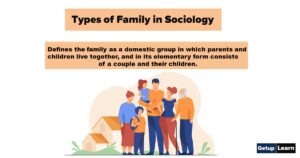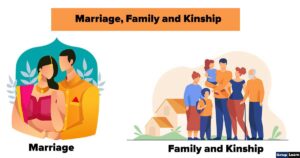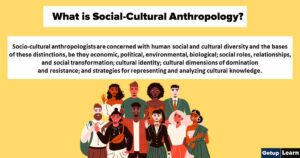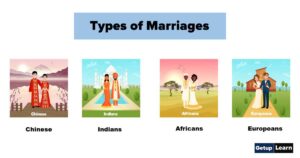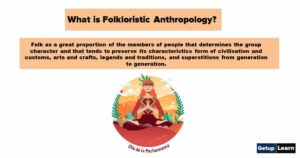Table of Contents
What is Kinship?
Kinship is one of the main organizing principles of society. It is one of the basic social institutions found in every society. This institution establishes relationships between individuals and groups. People in all societies are bound together by various kinds of bonds. The most basic bonds are those based on marriage and reproduction.
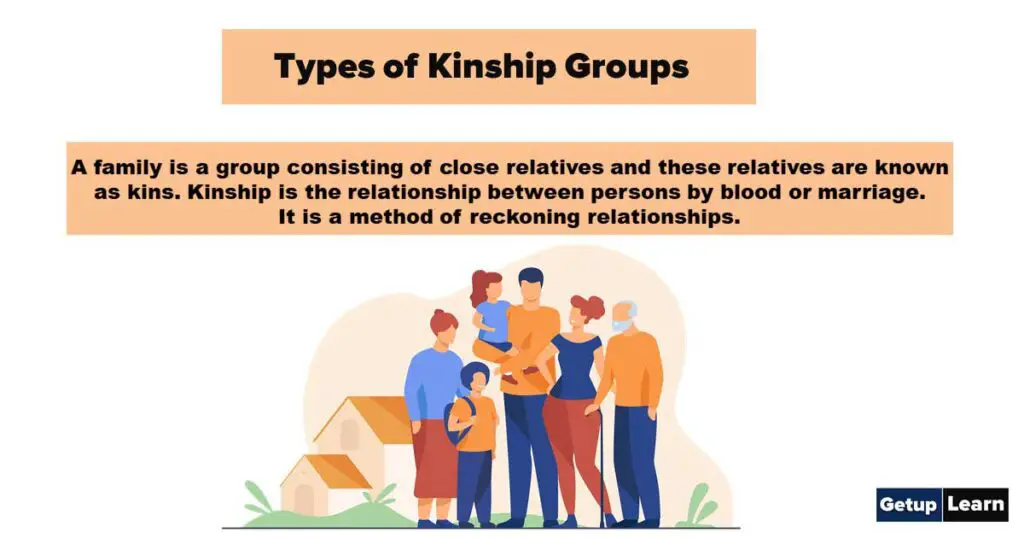
Table of Contents
Kinship refers to these bonds, and all other relationships resulting from them. Thus, the institution of kinship refers to a set of relationships and relatives formed thereof, based on blood relationships (consanguineal), or marriage (affinal).
Types of Kinship Groups
These are the types of kinship groups Sociological studies in various parts of North India show that social groups, such as:
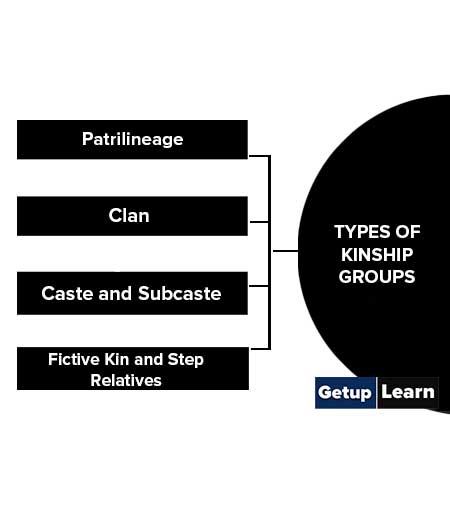
Patrilineage
You can say that broadly speaking unilineal descent groups are the basis of kinship organisation in North India. When you trace the lineage membership of a group on the basis of shared descent in one line, you can name it a unilineal descent group. In North India, you find mostly patrilineal descent groups.
This means that you trace the descent in the male line from father to son. Members of patrilineages cooperate as well as fight in various situations.
Let us find out how this takes place in terms of:
- Cooperation
- Conflict
- Inheritance of Status and Property
Cooperation
Members of a patrilineage cooperate in ritual and economic activities. They participate together in life cycle rituals. In the settlement of disputes, the senior men of the lineage try to sort out the matter within the lineage. Cooperation among lineage members is strengthened because they live close together in the same village.
As the farmlands of lineage members are normally located in the same village, they set up their houses almost next to each other. In this situation, there is the constant exchange of material resources from the household of one member to another.
From their studies of the kinship systems, you can say that these studies follow the descent approach because they examine the pattern of cooperation and conflict in descent groups.
Conflict
Lineage members help each other, but fights or conflicts also characterize kinship relations among them. For example, shows how in a Kashmir village, rivalry among brothers leads to the partition of the joint family. Later, this rivalry takes a more intense form in the relationships between the children of brothers.
Inheritance of Status and Property
Transmission of status and property from one generation to the next takes place according to certain rules. In North India, the status and property generally pass in the male line. In other words, you find a predominantly patrilineal mode of inheritance in North India. For this reason, the composition of patrilineage becomes very important.
The lineage members cooperate for economic and jural reasons. They share jural rights and therefore they cooperate in order to continue possessing the rights. They also fight among themselves about who is to get more benefits from those rights.
To keep the land within the lineage, its male members have to remain united. Land ownership in this case becomes the main principle of their social organization.
Clan
A lineage is an exogamous unit. This means that a boy and a girl of the same lineage cannot marry. A larger exogamous category is called the clan. Among the Hindus, this category is known as gotra. Each person of a higher caste among the Hindus belongs to the clan of his/ her father and cannot marry within the clan or gotra.
One usually knows about the common ancestor of lineage members as an actual person. But the common ancestor of a clan is generally a mythical figure. In rural areas, often the members of a lineage live in close proximity and therefore have greater occasions for cooperation or conflict.
Common interests or actions do not characterize the relationships among clan members because they are usually scattered over a larger territory and their relationships are often quite remote. You would observe that it is common to find these relationships assuming significance only in the context of marriage.
That is why we will now discuss caste/ sub-castes as the third characteristic feature of kinship groups in North India. Castes/subcastes are the endogamous units within which marriage takes place.
Caste and Subcaste
Besides lineages and clans, the kinship system operates within the families of the caste groups, living in one village or a nearby cluster of villages. As mentioned earlier, castes are endogamous, i.e., one marries within one’s caste and people belonging to one caste group are kinsmen in the sense that they are already related or can be potentially related to each other.
Caste-fellows generally come forward to help each other when others challenge their honor and status. They may also hold rituals together and help each other economically. Subcaste is the largest segment of caste and it performs nearly all the functions of castes, such as endogamy and social control.
In this respect, you can say that the internal structure of the subcaste would provide you the framework within which you can observe the operation of the kinship system. The members of a subcaste cooperate as kinspersons. They, depending on the context, work together as equals in the sphere of ritual activities and political allies in socio-economic activities.
Fictive Kin and Step Relatives
You need to also mention, in passing, the recognition of fictive kinship among both urban dwellers and villagers. Often, people who are not related either by descent or marriage, form the bonds of fictive kinship with each other. We find evidence of such a practice in many tribal and village studies.
Kinship Terminology
Let us go through different terms used to address kin. Kinship terms are the label, name or designation applied to relatives. It can be classified into three different types:

Mode of Use
According to mode of use, kinship terms are classified into terms of address and terms of reference:
Term of address is used, to call someone directly. Example Atta in Telugu; Amma in Tamil/Malayalam.
Term of reference is how you address someone when talking about them. It is used to designate a relative in speaking about the person to a third person. For Example, in traditional Kerala society, some women used to refer to their husbands in third person as ‘the father of the children’ instead of using ‘husband’. In Telugu, father’s sister is referred to as ‘Menatta’ but addressed as ‘Atta’.
Linguistic Structure
As per linguistic structure, kinship terms are classified as Elementary, Derivative and Descriptive types:
The elementary term consists of an irreducible word. For example ‘father’ or ‘mother’.
A derivative term is a compound form of elementary term and a lexicon. It is similar to the English words such as grandfather, sister-in-law, stepson, etc. In the term ‘grandfather’, ‘father’ is an elementary term and ‘grand’ is a lexicon without a particular kinship meaning. But when ‘grand’ and ‘father’ is combined, it gives a meaning.
The descriptive term is like Swedish word ‘farbror’ (father’s brother) which combines two or more elementary terms to denote a specific relative. ‘Ammamma’ and ‘Achchachan’ in Malayalam are some of the examples of descriptive terms.
Range of Application
According to the range of application, kinship terms are classified into Denotative and Classificatory term:
A denotative term denotes only one category of kins. For example in English, father, mother, husband and wife are denotative terms as they denote a single relationship.
A classificatory term is one that applies to two or more kinship categories. Grandfather, cousin, uncle and aunt are used to refer to more than one category of relatives. The term cousin is used to denote several relations like father’s sister’s children, mother’s brother’s children, etc.
Relationships within the family may vary from person to person according to the role and status they have in the particular family. Some relative tries to share lighter moments with each other, while they keep their distance from some others. You can observe such kinship behaviour in your family setting as well.
Kinship Behaviour
Kinship behaviour towards a particular relative is not the same in all societies. Most of the behaviour is culture-bound and therefore vary from society to society. Let us go through different types of such behaviour:
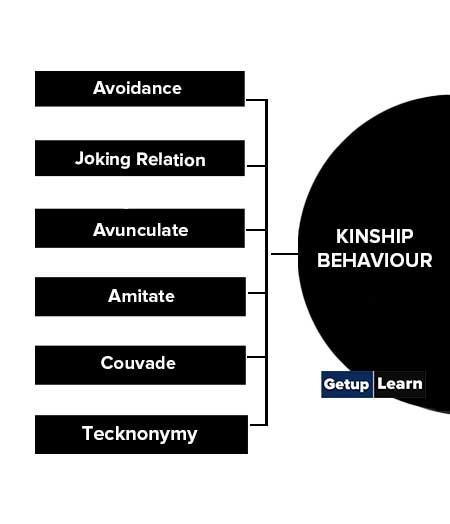
Avoidance
In many societies all over the world individual related to one another observe a kind of distance towards daughter-in-law, mother-in-law, father-in-law, younger brother’s wife, etc. For instance, a man maintains an avoidance relationship with his daughter-in-law according to traditional norms. In the same manner, a woman tries to avoid the presence of her son-in-law.
Such a relationship exists between a person and his younger brother’s wife.
Joking Relation
It is just the opposite of to avoidance relationship. The extreme degree of familiarity is expressed through joking relationships between certain kin relations.
Those who are in such relationships indulge in teasing each other by different kinds of jokes. Generally joking relationship exists between a man and his wife’s younger sisters, between a woman and her husband’s younger brothers, between cross cousins, between grandparents and grandchildren, etc.
Avunculate
In some matrilineal societies, the maternal uncle assumes many of the duties of the father. His nephew and niece remain under his authority. They inherit maternal uncle’s property. Trobriand Islanders of Melanesia exhibit such kind of behavior.
Amitate
This usage is similar to avunculate and found among patrilineal people. Here, the father’s sister gets great respect and prime importance. She is more than a mother to her nephew and exerts her authority on him in many events of life. Polynesian Tonga exhibits this kinship behaviour.
Couvade
This is a peculiar practice whereby the husband is required to imitate the process of pregnancy and all the behavior that is enjoined upon his wife for the sake of the child’s welfare. The husband leads an inactive life and imitates the taboos which the wife is supposed to follow in connection with the child’s birth. Tribal communities like the Todas, Uralis, and Nayadis used to practice this custom.
Tecknonymy
In many rural societies of India, it is quite common as a part of orthodoxy or of some convention to call or to refer to one’s husband as the father of her child. This usage is called Tecknonymy. Khasis of Meghalaya practice this.
FAQs About Kinship
What are the types of kinship groups?
The following are the types of kinship groups:
1. Patrilineage
2. Clan
3. Caste and Subcaste
4. Fictive Kin and Step Relatives.
What is kinship terminology?
The following is kinship terminology:
1. Mode of Use
2. Linguistic Structure
3. Range of Application.
What is kinship behavior?
The following is kinship behaviour:
1. Avoidance
2. Joking Relation
3. Avunculate
4. Amitate
5. Couvade
6. Tecknonymy.
YOU MIGHT ALSO LIKE
- What is Anthropology?
- Branches of Anthropology
- What is Social Anthropology?
- Scope of Social Anthropology
- Nature of Social Anthropology
- What is Social Cultural Anthropology?
- Theories of Sociocultural Anthropology
- What are Archaeological Sites?
- Types of Archaeological Sites
- What is Linguistic Anthropology?
- What is Marriage?
- Types of Marriage
- What is Family?
- Types of Family in Sociology
- Functions of the Family
- Folk literature
- What is Biological Anthropology?
- Biological Anthropology Fields of Study
- What is Social Anthropology?
- Definition of Social Anthropology
- Scope of Social Anthropology
- Nature of Social Anthropology
- What is archaeology?
- What is Archaeological Anthropology?
- Process of Archaeology
- Types of Archaeology Sites
- Linguistics Language
- Linguistic Culture
- Types of Marriages
- What is Kinship?
- Types of Kinship Groups
- What is Folkloristic Anthropology?

